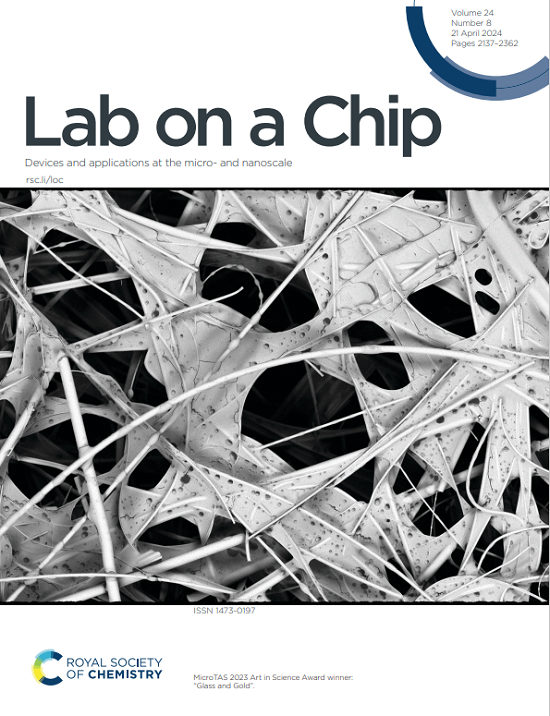Signal Amplification Using Ab-AuNPs Integrated with LDI-MS Analysis for Diabetes Screening in Urine and Saliva
IF 5.4
2区 工程技术
Q1 BIOCHEMICAL RESEARCH METHODS
引用次数: 0
Abstract
The global prevalence of diabetes is rising at an alarming rate, making it the third leading cause of death worldwide. This study presented a user-friendly, straightforward, and non-invasive method for screening diabetes. Various antibody-conjugated boronic acid-modified gold nanoparticles (Ab-AuNPs) were prepared, including anti-HbA1c, anti-HBA1, anti-HSA, anti-gHSA, and anti-insulin, to enable the specific recognition of their corresponding antigens in single droplet samples of urine and saliva on nitrocellulose membranes, with subsequent analysis performed using laser desorption/ionization mass spectrometry (LDI-MS). Ab-AuNPs absorbed ultraviolet laser light, leading to the direct desorption and ionization of Au+ ions. This process eliminated the need for an additional organic matrix in matrix assisted laser desorption/ionization mass spectrometry (MALDI-MS), effectively reduced interference from matrix-related ions, and significantly amplified the detection signal of Au+ ions at trace levels for targeted antigens in urine and saliva. The developed method revealed elevated levels of glycated proteins, including glycated hemoglobin (HbA1c) and glycated human serum albumin (gHSA), as well as human serum albumin (HSA), in diabetes patients compared to healthy individuals. In contrast, insulin levels were notably lower in diabetes patients. By analyzing these biomarker changes, we successfully identified the presence of diabetes. The reported method for screening diabetes in biological fluids provides a practical approach and holds significant promise for analyzing other diseases as corresponding biomarkers are discovered and their antibodies are developed and acquired in the future.利用Ab-AuNPs与LDI-MS分析相结合的信号放大技术筛查尿和唾液中的糖尿病
糖尿病的全球患病率正以惊人的速度上升,使其成为全世界第三大死亡原因。本研究提出了一种用户友好、直接、无创的糖尿病筛查方法。制备了多种抗体共轭硼酸修饰金纳米颗粒(Ab-AuNPs),包括抗hba1c、抗hba1、抗hsa、抗ghsa和抗胰岛素,使其能够在硝化纤维素膜上的尿液和唾液单滴样品中特异性识别相应的抗原,随后使用激光解吸/电离质谱(LDI-MS)进行分析。Ab-AuNPs吸收紫外激光,导致Au+离子直接解吸和电离。该方法在基质辅助激光解吸/电离质谱(MALDI-MS)中消除了对额外有机基质的需要,有效地减少了基质相关离子的干扰,并显著放大了尿液和唾液中痕量Au+离子对目标抗原的检测信号。该方法显示,与健康个体相比,糖尿病患者的糖化蛋白水平升高,包括糖化血红蛋白(HbA1c)、糖化人血清白蛋白(gHSA)以及人血清白蛋白(HSA)。相比之下,糖尿病患者的胰岛素水平明显较低。通过分析这些生物标志物的变化,我们成功地确定了糖尿病的存在。该方法在生物液体中筛选糖尿病提供了一种实用的方法,并为分析其他疾病提供了重要的希望,因为未来会发现相应的生物标志物,并开发和获得相应的抗体。
本文章由计算机程序翻译,如有差异,请以英文原文为准。
求助全文
约1分钟内获得全文
求助全文
来源期刊

Lab on a Chip
工程技术-化学综合
CiteScore
11.10
自引率
8.20%
发文量
434
审稿时长
2.6 months
期刊介绍:
Lab on a Chip is the premiere journal that publishes cutting-edge research in the field of miniaturization. By their very nature, microfluidic/nanofluidic/miniaturized systems are at the intersection of disciplines, spanning fundamental research to high-end application, which is reflected by the broad readership of the journal. Lab on a Chip publishes two types of papers on original research: full-length research papers and communications. Papers should demonstrate innovations, which can come from technical advancements or applications addressing pressing needs in globally important areas. The journal also publishes Comments, Reviews, and Perspectives.
 求助内容:
求助内容: 应助结果提醒方式:
应助结果提醒方式:


